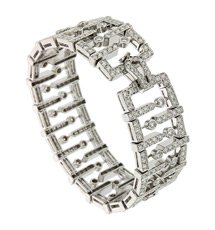Asterism
Derived from the ancient Greek word for “star,” asterism refers to intersecting lines of light in a gemstone. Six pointed stars are the most common, though four and twelve pointed stars also occur, depending on the molecular structure of the jewel. To best display a jewel’s asterism, the stone is cut into a cabochon, a circle or oval shape with a domed top. Sapphires and rubies are most famed for asterism, though other gemstones such as topaz, spinel, and even rose quartz may exhibit this phemonena. Asterism is usually caused by inclusions of the mineral rutile, also known as silk. Rutile often takes on needle like shapes. If the needle like stone lays in multiple directions, asterism may form. An ideal gem star should sit in the center of the cabochon, with straight rays that stretch from the middle all the way to the edges of the stone.
Alexandrite’s Color Change
Alexandrite is a type of chrysoberyl stone whose color changes depending on the ambient light. Due to the way chromium replaces some of the aluminum in the jewel’s crystal structure, alexandrite reacts differently to the color differences in sun and incandescent lights, turning blue green and deep red respectively. The phenomenon is so closely associated with alexandrite, that when stones such as corundum or spinel change colors, it’s called alexandrite-like. The most sought after alexandrite displays dramatic color change, transforming from red to green, rather than related hues such as blue and purple. Fine alexandrite ismore likely to have colors that bear gray or brownish casts than to achieve the saturation levels of ideal emeralds and rubies. Though its hues may not be as bright, alexandrite’s color change phenomena makes it a worthy addition to any collection.
Chatoyancy
Also known as cat’s eye, chatoyancy is a gemstone inclusion that creates a bright line inside a jewel. When centered in the middle of a stone, the beam of light resembles the pupil of a cat, inspiring the name. The cause of chatoyancy is narrow inclusions within the crystal which sit parallel to one another. Cutting the stone into a cabochon shape concentrates the light from these inclusions, creating the eye. Chatoyancy is most associated with chrysoberyl, though a variety stones including tourmaline and quartz may also exhibit cat’s eyes. One notable trait of chatoyancy involves shining two beams at opposite angles. This causes two lines to appear, giving the illusion of a wide pupil. Moving the lights back and forth causes the “eye” to open and close.
Labradorescence
A type of feldspar known as labradorite contains countless microscopic flecks which face one or occasionally two directions. At some angles, labradorite is a plain dark stone. When turned just so, the entire surface lights up, its plates reflecting brilliant colors. Its play of light is known as labradorescence. The hue most associated labradorescence is blue, though green, yellow or scraps of red may also appear. Rather than a uniform shade, labradorescence appears in gradient tones, shifting in saturation levels. Depending on the stone, a rainbow of colors shine throughout the labradorite’s surface.
Iridescence and Orient
The distinctive features of nacre and nacreous pearls include their cloudy gleam and the way rainbows slide over their surfaces. This occurs due to the platelets of calcium carbonate that make up nacre, which sit stacked on top of one another in staggered layers. This arrangement disrupts the flow of light, creating a gleam known as iridescence and orient. While iridescence in the gem world usually refers to nacre and nacreous pearls, there are exceptions. Conch pearls don’t have the staggered platelets of its nacreous cousins, but displays a flame like iridescence caused by long microscopic crystals that lay parallel to one another. Fire agate also disrupts light beautifully, throwing off gleaming red and yellows through alternating layers of silica and iron oxide.
Aventurescence
When light hits a gemstone, causing a flurry of metallic sparkles, the effect is called aventurescence. The phenomena is caused by countless inclusions within the stone that are oriented to reflect light. “Aventurescence” derives from the Italian words “a ventura,” or “by chance,” alluding to the accidental discovery of goldstone glass in the 18th century. Goldstone glass is a manufactured material often used in fashion jewelry, which shines from the copper glitter suspended inside. Unlike most simulants, aventurescence was named in honor of the glass, and later used to describe natural stones. Sunstone, also known as aventurine-feldspar, gleams with the help of copper flakes. Aventurine quartz is another example, reflecting light with the aid of chrome inclusions.
Milk and Honey
Chrysoberyl is one of a variety of stones that are able to obtain cat’s eyes. Though the alexandrite subgroup is famed for its ability to change color, the other type of chrysoberyl, cymophane, also has this ability. When combined with chatoyancy, two hues appear on the same stone. Cymophane is prized for its golden yellow color. Chrysoberyl, meaning “gold-white spar” in ancient Greek, is named in honor of the cymophane type. When a cat’s eye version of this stone is cut into cabochon and light hits the jewel at the right angle, the half of the gemstone closest to the light will retain its tawny hues, while the one in shadow takes on a cloudy white appearance. This is known as the milk-and-honey effect.





